The groundwater is polluted over a large area
© APA/dpa/Frank Rumpenhorst/futurezone
Andreea Bensa-Cruz
Imagine a kind of tea bag that you put in contaminated water holds and thus the pollutants picks up. Et voilà – you already have clean drinking water. In a similar way, efficient water purification could be possible in the future. This is also becoming increasingly urgent, because the groundwater is large-scale worldwide due to pollutants such as Pesticides, drugs or hormones burdened.
One of the most widely used herbicides is glyphosate, which is used to kill weeds. With current methods, the groundwater cannot be completely freed from it.
network of pores
A novel material created by a team around Dominik Ader from the Institute for Materials Chemistry at the Vienna University of Technology was developed to change that. These are so-called metal-organic frameworks or structures (MOFs), which consist of small metal-oxygen clusters. These are linked to organic molecules. This results in a highly porous, powdered material.
“This powder could be embedded in a membrane, for example, like tea leaves in a tea bag. This membrane must be water-permeable so that the organic or inorganic contaminants can get through and interact with the powder,” says Eder of futurezone.
The structures work particularly well for the glyphosate molecule. “This is because the active component in these MOFs are titanium atoms,” says the researcher. Titan can generally interact well with molecules that contain phosphate or phosphonate groups and form a bond. However, so that the glyphosate can also reach the titanium easily, larger pores were built into the molecular framework using a new method, thereby releasing some of the titanium atoms.
The molecular scaffolds remove glyphosate from groundwater
© Vienna University of Technology
Longer durability
These pores not only provide space for the molecules, they also activate the titanium in the first place. “You need this activation so that the impurity, i.e. the molecules, can dock there. Conventional MOFs do not have this docking point,” says the scientist. The team succeeded together with the Canadian University of Northern British Columbia3 times as much glyphosate in just 20 percent from the water in less time than the best adsorbent available today.
“The special thing is that this process is reversible and can be used several times. The glyphosate can then be flushed out with a simple sodium chloride saline solution,” says Eder. These special structures are already ready for use and can be scaled up and tested on an industrial scale.
Head of research Dominik Eder from the Vienna University of Technology
© Vienna University of Technology
Currently, however, there is still the problem of durability in water. In general, metal-organic frameworks come in hundreds of thousands of different structures, most of which decompose after a few hours in water. “Our MOFs are among the most stable currently available and last for several days. We also recently developed a new method that allows us to increase stability to several hundred days. This actually makes MOFs practical,” says Eder.
hormones in the water
In general, the MOFs could be used depending on the contamination. Glyphosate was recently banned in Europe, but the herbicide is still legal in the US and many developing countries. “There the removal from sewage can definitely help to improve the drinking water quality”.
In Austria, on the other hand, there are small amounts of in the drinking water Painkillers, antibiotics and hormone preparations available. Their concentration is currently still well below a health hazard. “At some point, however, this concentration will be so high that a health risk can be assumed. Then we need these new technologies to remove the substances.”
In the future, tests with inorganic substances such as Nitrate und Sulfate be performed. These pollute the wastewater through intensive agriculture.
A research team around Gunnar Westman of the Chalmers University of Technology in Sweden has in common with the Malaviya National Insititute of Technology Jaipur in India developed a method to remove contaminants in water using a wood-based material. In particular, it is about the removal of toxic dyes from the textile industry from the wastewater.
Tiny ones are used Cellulose nanocrystals. They have a particularly efficient adsorption capacity. A bio-based material was specifically developed. This is a form of cellulose powder with cleaning properties that can be adjusted and modified depending on the type of pollutants to be removed. In a study Westman and his team showed how the material can be used to remove toxic dyes from wastewater.
degradation by sunlight
The low-cost system can be thought of as a portable box that plugs into the sewer line. The waste water flows through the cellulose powder filter where the pollutants are absorbed. Sunlight causes these to break down quickly and efficiently. Pressure and heat are not required.
The innovation could especially benefit countries with insufficient water treatment technologies.


